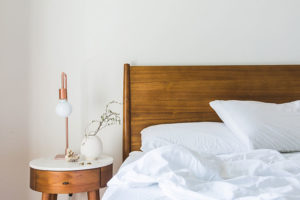One of the critical factors for a good quality of life is sleep. Getting enough sleep and living a healthy life go hand in hand; health issues such as depression create sleep disturbances, and people with insomnia are more likely to experience depression. That’s because there are few experiences as frustrating as getting into bed after a long day just to spend the night tossing around and turning without successfully dozing off.
On average, it takes most people only 10-20 minutes to fall asleep. Those who have trouble dozing off occasionally or have insomnia can take over an hour to finally rest.
If you struggle with falling asleep and you’re suffering because of it, you might want to take some advice from the military. In 1981, Lloyd Winter published Relax and Win: Championship Performance, which revealed a US military tactic that soldiers use in combat to fall asleep under intense conditions.
Here’s how US military troops fall asleep in 2 minutes:
Set the Environment
Make sure the setting is right for a good night’s rest:
- Do you have to work the following day? Set the alarm to make sure you aren’t stressed about getting up on time.
- Put your phone on silent to prevent any late-night texts or notifications that could wake you up with the bright screen illuminating or making a noise.
- Turn off all of the lights (your bedside lamp can stay on if you wish).
Relax Your Body
It is time to sit back, get comfortable, and relax your body.
Start with the muscles of your face – concentrate on each region of your face separately:
- Notice your forehead; is it creased? Relax all of your face muscles, starting at the top of your head down to your chin.
- Don’t shut your eyes super tight. Instead, have your lids casually and lightly closed.
- Is your tongue pressed to the roof of your mouth? Lower it so that it rests on the bottom.
Lower Your Shoulders
We carry a lot of tension on our shoulders without even realizing it. Now is the time to acknowledge that weight. However, you want to relax the area every night slowly, so you sink deeper into comfort.
Drop your shoulder joints as deep down as they can go. You might also have stiffness in the arms and hands due to tense shoulders; if so, invite one arm at a time to soften as the shoulders go down.
Relax the Lower Body
Once your head and arms are relaxed, you can slowly start to drag your awareness downwards. As you notice your chest, intentionally let it relax and sink into your mattress. Once your chest muscles relax, you can bring awareness to your leg muscles.
For your legs, use the same process as your arms, where you do one side at a time.
Clear Your Mind
After your entire body is relaxed, you should spend at least 10 seconds clearing your mind. Release any thoughts from your head. If you have an important meeting coming up that you don’t want to forget about, replace these thoughts by repeating, “don’t think” ten times.
When any thought comes your way, just let it pass. Take deep breaths and keep your body limp. Allow gravity to help further relax your whole body.
Visualize
Visualization tactics are a method of mind-clearing, but you should still start off by trying to clear your mind without the aid of any visualizations:
- Imagine yourself relaxing and laying in a hammock made of black velvet in a dark room.
- Picture yourself sitting inside a canoe, floating on a calm lake. There is nothing but a clear blue sky overhead, and you have nowhere else to be.
Visualization doesn’t come easily to everybody. If neither of these visualization ideas is doing the trick for you, try simply concentrating on the phrase “don’t think” and repeat it for 10 seconds in your head.
Just Breathe
Focus only on your breath in and your breath out. There is no need to concern your mind with anything else at this moment.
Go to Sleep
Turn off the bedside table lamp if you left it on, get cozy, and try to fall asleep. If this technique works for you, you should be drifting off within two minutes.
Other Ways to Achieve a Full Nights Rest
A lack of sleep is a bigger problem than a simple inconvenience: if this is a consistent problem, and you can’t wake up later the next day to compensate for time lost. This means you are waking day after day with not enough hours of sleep under your belt.
When you’re consistently not getting enough sleep, the sleep deprivation begins to take a toll on your body. According to the Mayo Clinic, this will lead to serious health problems, such as:
- Decreased sex drive
- Depression
- Diabetes
- Forgetfulness
- Weight gain
- Advanced skin aging
- Impaired judgment
- Cardiovascular disease
- In severe cases, death
If you increase your chance of falling asleep early, consider trying these other options as well:
Lower the Thermostat
As you fall asleep, your body temperature will change. Your body will naturally cool down as you fall asleep and heat back up when you wake up. If your room is too warm, this could a cause of your restlessness.
Stick to a Schedule
Set a specific time that you want to go to bed and stick to it every night (or at least Monday through Friday). Going to bed and waking up at the same time every day restores patterns of sleep, and you may find falling asleep easier than usual.
Cut Out Naps
If you’re prone to poor sleep, it can be easy to fall into a daytime napping schedule. Unfortunately, this can negatively affect your nighttime sleep schedule.
Cut out daytime naps to ensure a full night of rest. If you’re not sure how much sleep you should be getting, the National Sleep Foundation recommends 7-9 hours of sleep.
Conclusion
Perfecting this sleeping hack is important if you struggle to get adequate rest at night. It’s a skill you can carry with you to any sleeping environment after about six weeks of diligent practice.
If you want to get the NHS recommended hours of quality sleep each night, try out this method every night for the best results.



